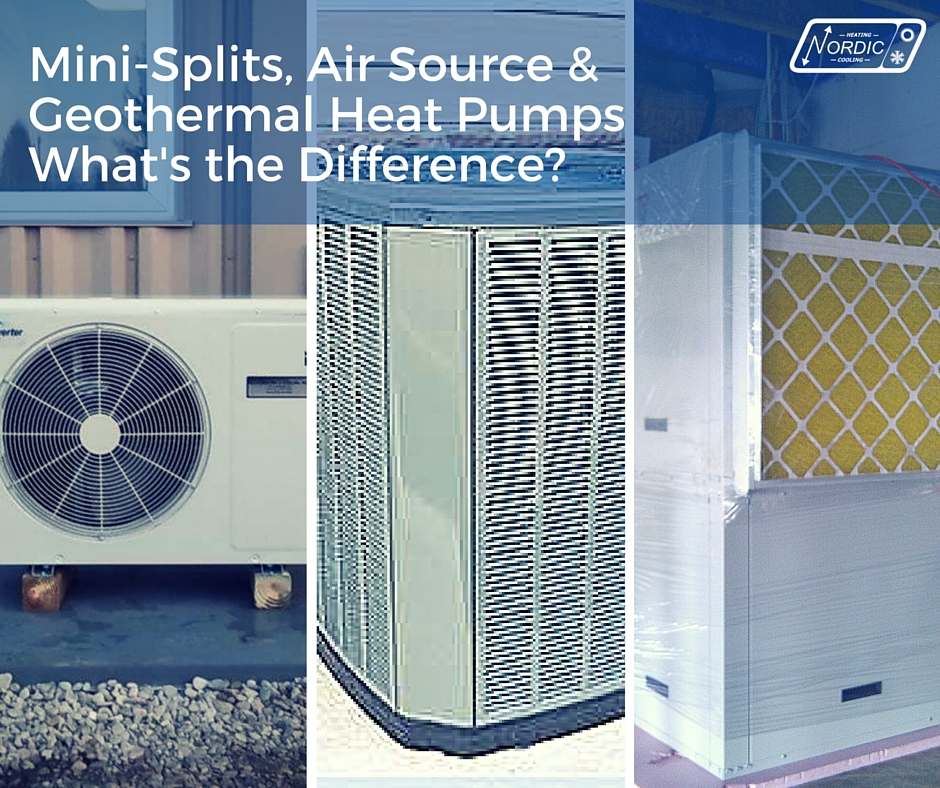The province of New Brunswick recently released a new rebate on heat pumps, that allows homeowners to claim $500 when they install a ductless mini-split heat pump in their home. This has resulted in a surge in popularity for ductless mini-split heat pumps, with more units being installed every day by homeowners looking to save money on their heating bills.
The problem is, contractors in that province are receiving more phone calls than ever from homeowners who have had heat pumps installed, but the heat pumps aren’t living up to their expectations. It seems that some installers are overselling the heat pumps and misrepresenting their capabilities, benefits, drawbacks and how much they can reduce heating bills.
There seems to be some confusion among homeowners about the capabilities of the heat pump they purchased. We think that’s in part because there are actually three different types of heat pumps: mini-splits, air source, and geothermal, and all of them have unique capabilities, features, and limitations. To help clear up the confusion once and for all, we’re going to outline the key differences between the three types of heat pumps.
Energy Distribution System
The energy distribution system is how the heat pump actually delivers heat into your home. The three heat pumps outlined above each have a different energy distribution system, which makes them ideally suited to different applications. Let’s have a look at them now:
A ductless mini-split heat pump has a ductless heat distribution system just like the name suggests. With this heat pump, heating and cooling is delivered through the air from a single air handler. This air handler is usually placed in the main part of an open concept house.
Most air source heat pumps most commonly deliver heating and cooling through centralized ductwork. The ductwork distributes heating and cooling evenly throughout the home.
Geothermal heat pumps are the most versatile of the three units. Depending on what you need, geothermal heat pumps can deliver heating and cooling through air ducts, through radiant in-floor heating or through a combination of the two.
Capability
It’s important to consider what capability you want your new home heating system to have. Do you need your new system to provide heating and cooling to your whole home, or are you comfortable with a heating system that will only heat part of your home, the way a fireplace might? This is an important distinction, because the three heating systems we’re looking at today have different capabilities.
A mini-split delivers heating and cooling from a single point air handler, which means it is not an ideal whole-home heat pump. Usually, a mini-split is installed in the main part of an open concept house, and electric baseboards are installed in the rest of the home to supplement the heating it provides. A single mini-split is not capable of heating a whole home. Most mini-splits are suitable for spaces between 375 – 750 square feet. Alternatively, large homes could have three or four mini-splits installed throughout the home to deliver enough heat to keep the entire space warm in winter.
In contrast, a single air source heat pump can deliver whole home heating and cooling and is suitable for the average fully detached home. The average air source heat pump is suited to a home between 1,400 and 3,100 square feet.
Geothermal heat pumps also offer whole home heating and cooling through either forced air ductwork, radiant in-floor heat, or both. Geothermal heat pumps are available in a wide variety of sizes making them suitable for homes ranging from 1,000 to 4,200 square feet. Geothermal heat pumps also come equipped with a desuperheater which allows them to efficiently preheat your domestic hot water.
Energy Supply Source
A heat pump’s energy supply source is where it harvests its heat from. Remember, a heat pump just moves heat from one place to another. A mini-split harvests its heat from the outdoor air via a refrigeration process. The major drawback of using the outdoor air as a heat source is that when the temperature drops, the heat output of the unit also drops. Most mini-splits have a lowest operating temperature (the lowest temperature that they can still harvest heat from the air) of 5°F (-15°C), and some will draw heat at temperatures as low as -4°F (-20°C). After that, you’ll have to rely on back-up heat.
Air source heat pumps, as their name suggests, also use the outdoor air as their heat source. Most air source heat pumps have a lowest operating temperature of -4°F (-20°C). After that, electric back-up heat kicks in, which can be expensive to operate.
Geothermal heat pumps are a different story. Unlike the two types of heat pumps mentioned above, geothermal heat pumps use the ground as a heat source. Plastic piping is buried beneath the frost line where the ground maintains a constant temperature year-round. No matter how cold it gets outside, the ground maintains this constant temperature, providing a consistent heat source for your heat pump. This means a geothermal heat pump has no lowest operating temperature, and can provide your home with consistent, comfortable heat year-round without the use of back-up heat.
Average Energy Savings
Finally, the last major difference between these three units is the energy savings you can expect from them. All of these units will save you money over conventional electric baseboard heat, but the question is how much?
Mini-split heat pumps will save you between 20 – 40% on your heating bill. Don’t forget that in temperatures below 5°F (-15°C), you’ll have to rely on back-up heating, which will drive your utility bills up. You’ll also need to use alternative heat sources (like electric baseboards) in rooms that are far away from the mini-split air handler.
Air source heat pumps eliminate the need for alternative heat sources in good weather because they offer whole home heating and cooling via a ducted system that runs throughout the home. As a result, you can expect to save 30 – 40% on your heating bills with an air source heat pump. Your heat pump’s efficiency will decrease as the temperatures go down, and you’ll still need backup heat in cold temperatures.
Geothermal heat pumps do not lose efficiency in winter because their heat source is the earth, which is always consistently warm no matter what is happening in the air above. You won’t have to rely on back-up heat, which means you’ll save up to 75% on your heating costs with this type of heat pump.
All three heat pumps have their ideal uses in different situations, and it’s important to select the heat pump that will work best for your unique situation. Here’s a summary of the details we discussed:
Mini-Split vs. Air Source vs. Geothermal Heat Pumps
| Mini-Split | Air Source | Geothermal | |
|---|---|---|---|
| Distribution Type | Single-point air handler | Ducted air | Ducted air, radiant inf-loor |
| Capabilities | Single-point heating and cooling | Whole-home heating and cooling | Whole home heating, cooling and domestic hot water |
| Home Size | 375 - 750 sq. ft. | 1,400 - 3,100 sq. ft. | 1,000 - 4,200 sq. ft. |
| Energy Supply Source | Outdoor air | Outdoor air | Open or closed ground loop |
| Lowest Operating Temperature | -15°C | -20°C | No lowest temperature |
| Back-Up Heat Required? | Yes | Yes | No |
| Average Energy Savings | 20 - 40% | 30 - 40% | Up to 75% |
Interested in learning more? Download our Ebook: Geothermal Energy: Consistent, Comfortable and Cost Effective Heating and Cooling for Your Home.


